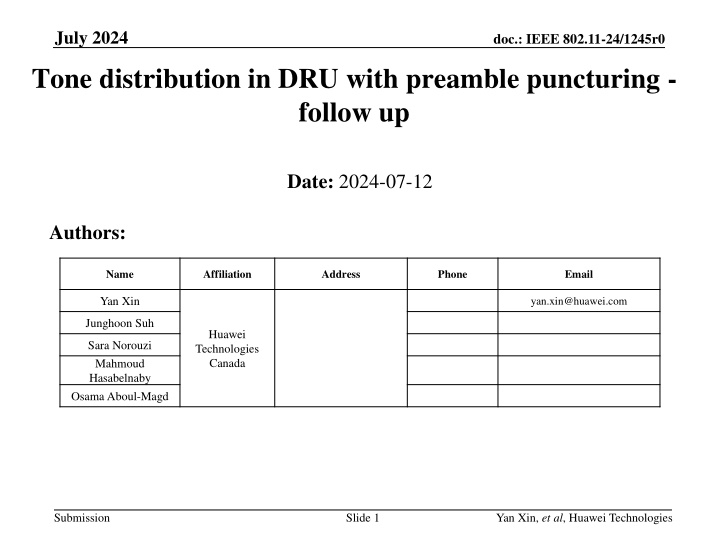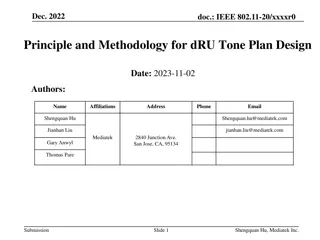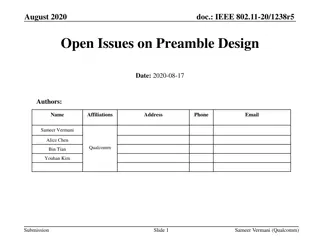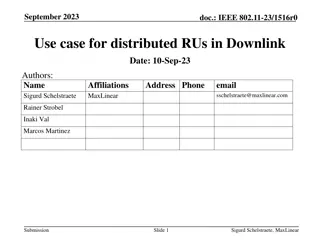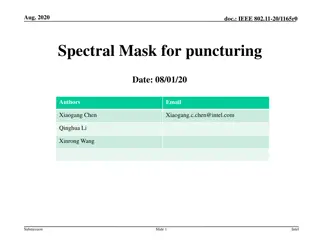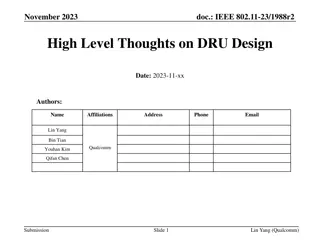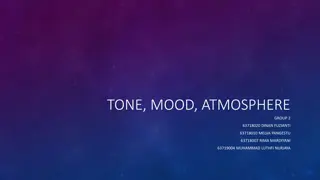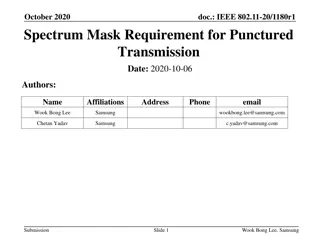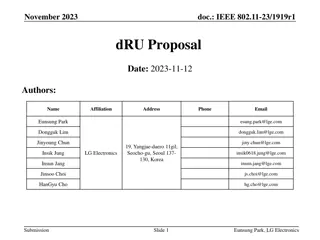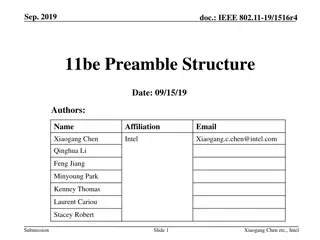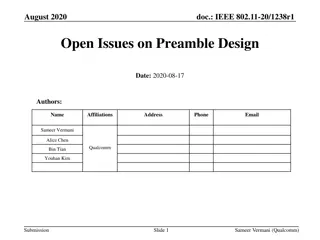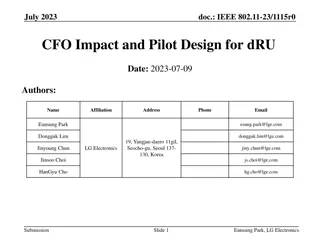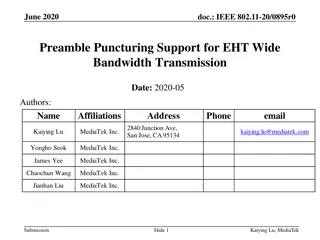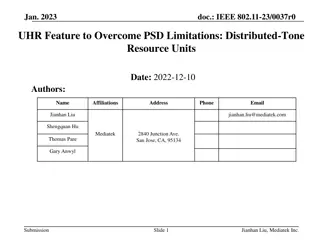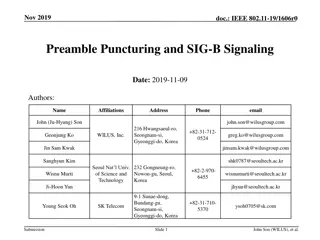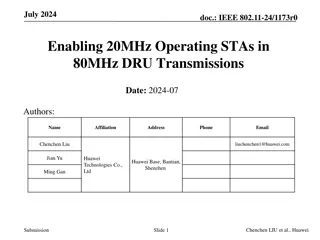Tone Distribution in DRU with Preamble Puncturing
The document discusses tone distribution in Distributed RU (DRU) with preamble puncturing in IEEE 802.11 networks. It explores the impact of preamble puncturing on subcarrier distribution and proposes solutions to optimize tone plans in DRU designs. Various rearrangements and tone distribution strategies are presented to address the challenges posed by preamble puncturing, ensuring efficient utilization of available spectrum bandwidth.
Download Presentation

Please find below an Image/Link to download the presentation.
The content on the website is provided AS IS for your information and personal use only. It may not be sold, licensed, or shared on other websites without obtaining consent from the author.If you encounter any issues during the download, it is possible that the publisher has removed the file from their server.
You are allowed to download the files provided on this website for personal or commercial use, subject to the condition that they are used lawfully. All files are the property of their respective owners.
The content on the website is provided AS IS for your information and personal use only. It may not be sold, licensed, or shared on other websites without obtaining consent from the author.
E N D
Presentation Transcript
July 2024 Tone distribution in DRU with preamble puncturing - follow up doc.: IEEE 802.11-24/1245r0 Date: 2024-07-12 Authors: Name Affiliation Address Phone Email Yan Xin yan.xin@huawei.com Junghoon Suh Huawei Technologies Canada Sara Norouzi Mahmoud Hasabelnaby Osama Aboul-Magd Submission Slide 1 Yan Xin, et al, Huawei Technologies
July 2024 doc.: IEEE 802.11-24/1245r0 Introduction Distributed RU (DRU) has been proposed [1] to maximize per-subcarrier transmit power. DRU tone plan designs have been outlined in [2, 3]. In 802.11be, the preamble puncturing feature is specified, in which no signal is present in at least one of the 20 MHz subchannels within a PPDU bandwidth larger than or equal to 80 MHz due to unavailability of 20 MHz subchannel(s). Furthermore, when a 20 MHz subchannel is used by a 20 MHz operation device, this 20 MHz subchannel may not be available for tone distribution in DRU over 80 MHz. DRU designs in [2, 3] have not considered the cases of preamble puncturing. When one 20 MHz subchannel is punctured in an 80 MHz PPDU, it implies that subcarriers can be distributed over a maximum 60 MHz spectrum. In [4], it is proposed to distribute subcarriers only over 20 MHz and 40 MHz, resulting in 4.7 dB and 1.7 dB losses in terms of per-tone transmit power for 242-tone DRUs, respectively, when compared to tone distribution over the maximum available 60 MHz. In [5], preamble puncturing is taken into account in DRU. All subcarriers are distributed over the maximum available spectrum for DRU through interleaving. This contribution further considers DRU designs for the case when one or two subchannels within the PPDU BW are unavailable for tone distribution. Submission Slide 2 Yan Xin, et al, Huawei Technologies
July 2024 doc.: IEEE 802.11-24/1245r0 Rearrangement of EHT RRUs Rearrangement of EHT 26-, 52- and 106-tone RRU indexing per 20 MHz Rearrangement of EHT 242-tone RRU indexing in an 80 MHz PPDU Note These rearrangements are for DRU design only. Submission Slide 3 Yan Xin, et al, Huawei Technologies
July 2024 doc.: IEEE 802.11-24/1245r0 Tone distribution per 20 MHz Universal one-to-one mapping between 26-, 52- and 106-tone distribution indices and 242-tone indices per 20 MHz Submission Slide 4 Yan Xin, et al, Huawei Technologies
July 2024 doc.: IEEE 802.11-24/1245r0 242-tone DRU tone indices in an 80 MHz PPDU with all subchannels available for tone distribution Submission Slide 5 Yan Xin, et. al, Huawei Technologies
July 2024 doc.: IEEE 802.11-24/1245r0 26-, 52- and106-tone distribution related to 242-tone DRU1 in an 80 MHz PPDU Note: 1) -> j denotes an index is right-shifted j positions; 2) index right-shifting is counted one when it is shifted from [-12] to [12]; 3) denotes an equivalent notation Submission Slide 6 Yan Xin, et al, Huawei Technologies
July 2024 doc.: IEEE 802.11-24/1245r0 26-, 52- and106-tone distribution related to 242-tone DRU2 in an 80 MHz PPDU Submission Slide 7 Yan Xin, et al, Huawei Technologies
July 2024 doc.: IEEE 802.11-24/1245r0 26-, 52- and106-tone distribution related to 242-tone DRU3 in an 80 MHz PPDU Submission Slide 8 Yan Xin, et al, Huawei Technologies
July 2024 doc.: IEEE 802.11-24/1245r0 26-, 52- and106-tone distribution related to 242-tone DRU4 in an 80 MHz PPDU Submission Slide 9 Yan Xin, et al, Huawei Technologies
July 2024 doc.: IEEE 802.11-24/1245r0 Tone distribution in 242-tone DRUs in an 80 MHz PPDU with the last 20 MHz subchannel unavailable for tone distribution across 20 MHz subchannels Assume that the last 20 MHz subchannel is unavailable for tone distribution across 20 MHz subchannels Tone distributions of 242-tone DRU1, DRU2 and DRU3 are: Submission Slide 10 Yan Xin, et al, Huawei Technologies
July 2024 doc.: IEEE 802.11-24/1245r0 Tone distribution in an 80 MHz PPDU with the last 20 MHz subchannel punctured for tone distribution across 20 MHz subchannels Submission Slide 11 Yan Xin, et. al, Huawei Technologies
July 2024 doc.: IEEE 802.11-24/1245r0 Tone distribution in an 80 MHz PPDU with the last 20 MHz subchannel punctured for tone distribution across 20 MHz subchannels Submission Slide 12 Yan Xin, et al, Huawei Technologies
July 2024 doc.: IEEE 802.11-24/1245r0 Tone distribution in an 80 MHz PPDU with the last 20 MHz subchannel punctured for tone distribution across 20 MHz subchannels Submission Slide 13 Yan Xin, et al, Huawei Technologies
July 2024 doc.: IEEE 802.11-24/1245r0 Tone distribution in an 80 MHz PPDU with the second last 20 MHz subchannel unavailable for tone distribution across 20 MHz subchannels Assume that the second last 20 MHz subchannel is unavailable in tone distribution across 20 MHz subchannels Tone distributions of 242-tone DRU1, DRU2 and DRU3 are: Submission Slide 14 Yan Xin, et al, Huawei Technologies
July 2024 doc.: IEEE 802.11-24/1245r0 Tone distribution in an 80 MHz PPDU with the second 20 MHz subchannel punctured for tone distribution across 20 MHz subchannels Assume that the second 20 MHz subchannel is punctured in tone distribution across 20 MHz subchannels Tone distributions of 242-tone DRU1, DRU2 and DRU3 are: Submission Slide 15 Yan Xin, et al, Huawei Technologies
July 2024 doc.: IEEE 802.11-24/1245r0 Tone distribution in an 80 MHz PPDU with the first 20 MHz subchannel being unavailable for tone distribution across 20 MHz subchannels Assume that the first 20 MHz subchannel is unavailable for tone distribution across 20 MHz subchannels Tone distributions of 242-tone DRU1, DRU2 and DRU3 are: Submission Slide 16 Yan Xin, et al, Huawei Technologies
July 2024 doc.: IEEE 802.11-24/1245r0 Tone distribution in 242-tone DRUs in an 80 MHz PPDU with the last two 20 MHz subchannels unavailable for tone distribution across 20 MHz subchannels Assume that the last two 20 MHz subchannels are punctured. Data/pilot tones are distributed over the first two 20 MHz subchannels only. - Note: This assumption is only for the DRU tone distribution design for the case specified in E HT, i.e., two 20 MHz subchannels in the middle are punctured, without any purpose to introduce of a new puncturing pattern. Tone distributions of 242-tone DRU1 and DRU2 are: Submission Slide 17 Yan Xin, et al, Huawei Technologies
July 2024 doc.: IEEE 802.11-24/1245r0 Tone distribution in an 80 MHz PPDU with the last two 20 MHz subchannels unavailable for tone distribution across 20 MHz subchannels Submission Slide 18 Yan Xin, et al, Huawei Technologies
July 2024 doc.: IEEE 802.11-24/1245r0 Tone distribution in an 80 MHz PPDU with the last two 20 MHz subchannels unavailable for tone distribution across 20 MHz subchannels Submission Slide 19 Yan Xin, et al, Huawei Technologies
July 2024 doc.: IEEE 802.11-24/1245r0 Tone distribution in 242-tone DRUs in an 80 MHz PPDU with the two middle 20 MHz subchannels unavailable for tone distribution across 20 MHz subchannels Assume that the last 20 MHz subchannel is unavailable for tone distribution across 20 MHz subchannels Tone distributions of 242-tone DRU1 and DRU2 are: Submission Slide 20 Yan Xin, et al, Huawei Technologies
May 2024 doc.: IEEE 802.11-24/1245r0 Summary This contribution proposes an efficient design method for tone distribution in DRU with preamble puncturing. Since in EHT, preamble puncturing is 20 MHz-based, distributed tone indices in 26-, 52- and 106-tone DRUs are designed to have universal one-to-one mapping with the indices of a 242-tone DRU. Tone indices of 242-tone DRUs are specified based on the status of subchannel puncturing, either without puncturing or with one or two subchannels punctured, in an 80 MHz PPDU. The indices of 26-, 52-, 106- and 242-tone DURs can be simply derived from those corresponding to the based DRU only with index shifting. Simple group index shifting is applied when one or two subchannels are unavailable for across 20 MHz tone distribution. Submission Slide 21 Yan Xin, et al, Huawei Technologies
May 2020 doc.: IEEE 802.11-24/1245r0 Reference [1] 802.11-23-0037r0, UHR Feature to Overcome PSD Limitations: Distributed-Tone Resource Units, Jan. 2023. [2] 802.11-23/2021r1, Principle and methodology for DRU tone plan design, Jan. 2024. [3] 802.11-24/0468r2, DRU tone plan for 11bn, May 2024. [4] 802.11-24/0726r2, Distribution Bandwidth within 80 MHz for DRU, May 2024. [5] 802.11-24/814r0, Tone distribution in DRUs, May 2024. Submission Slide 22 Yan Xin, et al, Huawei Technologies
May 2024 doc.: IEEE 802.11-24/1245r0 SP1 Do you agree to include the following text in the 11bn SFD? - A DRU bandwidth of 60 MHz is defined in an 80 MHz PPDU? Yes No Abstain Submission Slide 23 Yan Xin, et al, Huawei Technologies
